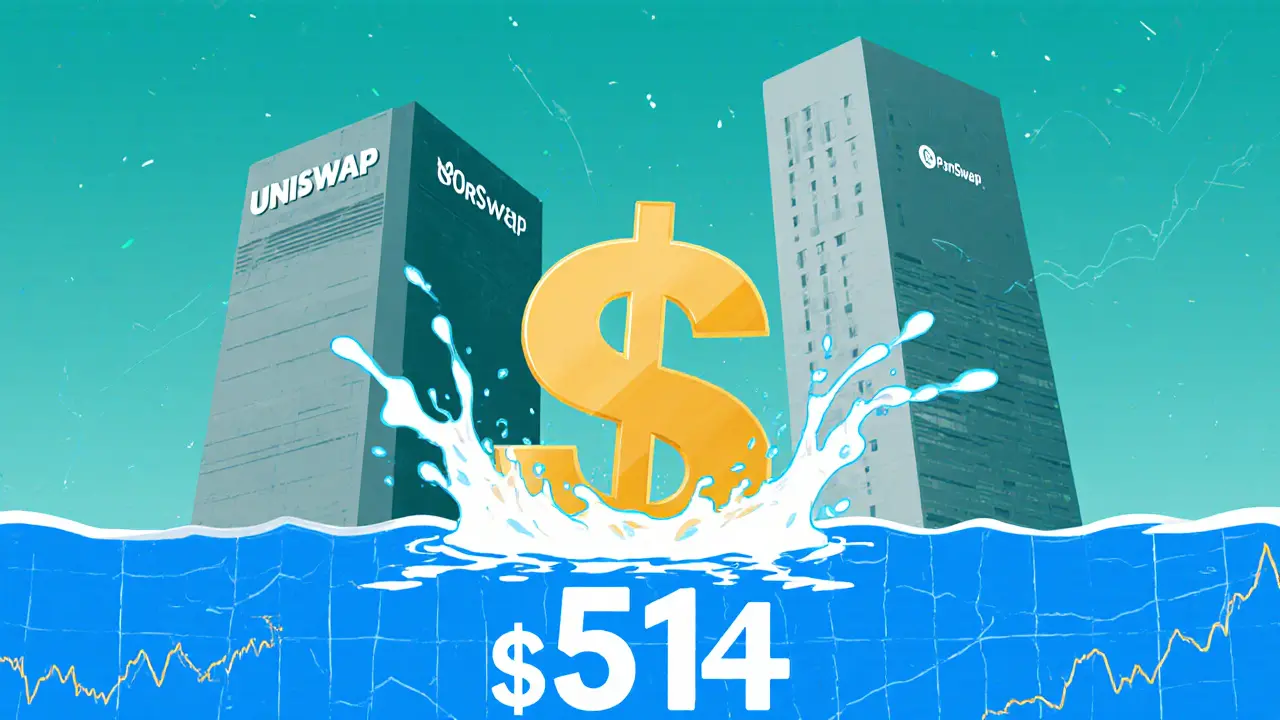DYORSwap Slippage Calculator
DYORSwap currently has shallow liquidity (depth ≈ $514) which causes significant slippage for trades above $100. Use this calculator to estimate how much slippage your trade might experience.
Estimated Slippage
How it works: Slippage occurs when your trade size exceeds available liquidity. At current depth ($514), a $500 trade would move the price significantly.
Formula: (Trade Amount / Liquidity Depth) × 100 = Slippage Percentage
Key Takeaways
- DYORSwap is Sonic's native DEX and the top venue for SONIC/WS trading.
- Daily volume sits at about $290, with shallow depth (≈$514 ±2%).
- Trading fee is 0.3% (0.62% spread) - cheap, but low liquidity drives high slippage.
- On‑boarding requires SONIC, the S validator token, and a functioning Sonic Gateway bridge.
- Liquidity‑mining program slated for Q4 2025 may boost pools, but adoption remains the biggest hurdle.
What is DYORSwap?
DYORSwap is the primary decentralized exchange built on the Sonic blockchain. It works like Uniswap on Ethereum but is tightly woven into Sonic's validator economics, letting dApps keep up to 90% of blockchain fees. The platform's main trading pair is SONIC/WS (Wrapped Sonic), which captured 101.09% of the 24‑hour Sonic‑token volume on CoinGecko in October 2025.
How the Exchange Operates
DYORSwap uses an automated market maker (AMM) model with a flat 0.3% fee. Sonic’s fee‑sharing scheme means most of the fee stays in the ecosystem, an advantage for developers building on the chain. Transaction finality is under two seconds, and gas costs average less than $0.0001, thanks to Sonic’s parallel‑processing architecture capable of ~10,000 TPS.
The Sonic Gateway bridge lets users move assets between Ethereum and Sonic in roughly ten minutes. If Sonic goes down for more than 14 days, the bridge has a fail‑safe that lets users withdraw on Ethereum.
Liquidity Reality Check
The numbers tell a stark story. With $290 daily volume and a +2% depth of $514, a $500 trade already moves the market significantly. By comparison, Uniswap V3 processes $1.2 billion daily and PancakeSwap around $800 million. DYORSwap’s share of total DEX volume (<0.0000015%) makes it a niche playground for Sonic enthusiasts rather than a mainstream trading hub.
Low liquidity also means higher slippage. Traders often see price impact well above 1% on modest swaps, which can erode the cheap‑fee advantage.

User Experience & On‑boarding
Getting started is a multi‑step trek:
- Buy SONIC on a centralized exchange (Binance, KuCoin, MEXC).
- Bridge SONIC to Sonic via the Sonic Gateway. You’ll need some S token (the validator stake token) to pay gas.
- Connect a Sonic‑compatible wallet (MetaMask with custom RPC, Sonic Wallet, or Ledger).
- Swap on DYORSwap.
Because the bridge requires S tokens for gas, users who bridge without holding S get stuck - a pain point mentioned in dozens of Reddit and Discord posts. Coincub’s usability test found 78 % of first‑time users needed help, with onboarding averaging 47 minutes versus about 12 minutes on Uniswap.
Security, Risks & Community Sentiment
DYORSwap inherits Sonic’s security model: validators must stake 500,000 S (≈ $42) to run a node. This high barrier helps protect the network but also limits decentralisation of validator participation.
Community sentiment in the Telegram “Sonic Degens” group sits at roughly 2.8/5. Positive feedback centers on sub‑second transaction speed; negative feedback focuses on liquidity gaps and the circular gas‑fee issue.
Regulatory exposure is unclear - Sonic hasn’t published formal compliance documents, leaving the DEX in a gray area similar to other decentralized platforms.
How DYORSwap Stacks Up Against the Big Dogs
| Exchange | Daily Volume (USD) | Liquidity Depth (+/-2%) | Fee (base) | Token Variety |
|---|---|---|---|---|
| DYORSwap (Sonic) | $290 | $514 / $512 | 0.3% (0.62% spread) | SONIC‑based pairs only |
| Uniswap V3 | $1.2 B | > $2 B | 0.3% | Thousands of ERC‑20 tokens |
| PancakeSwap | $800 M | > $1 B | 0.2% - 0.25% | Binance‑Smart‑Chain tokens |
Future Outlook & Potential Upside
Sonic’s roadmap includes a Q4 2025 liquidity‑mining program aimed at deepening DYORSwap pools. If successful, the depth could rise into the low‑thousands, cutting slippage for moderate traders.
Price forecasts for SONIC are wildly divergent - from a speculative $5.16 by 2040 (CoinLore) to a more conservative $0.27‑$0.34 for 2025 (TradingBeast). DYORSwap’s fortunes are tightly coupled to SONIC’s market adoption; a rally in the token could draw more traders, while continued price decline may keep liquidity thin.
Analysts agree the technical foundation (fast finality, negligible gas) is solid. The real test is whether the ecosystem can attract dApps and users fast enough to overcome the early‑stage liquidity problem before the DeFi market consolidates further around established Layer‑2 solutions.
Quick FAQ
Is DYORSwap safe to use?
The platform inherits security from the Sonic blockchain, which relies on staked validators. No major hacks have been reported, but the low liquidity makes price manipulation easier, so use small amounts until depth improves.
How do I pay gas on Sonic?
Gas is paid with the S token. You need to hold a small amount of S in the same wallet you use to bridge assets.
What pairs can I trade on DYORSwap?
Currently only SONIC‑based pairs are supported, the most liquid being SONIC/WS. New pairs may be added as the ecosystem grows.
Will the upcoming liquidity‑mining program help?
If the program attracts enough stakers, depth could rise into the low‑thousands, reducing slippage. Early reports suggest interest, but the impact will only be clear after the program runs for a few weeks.
How does DYORSwap compare to Uniswap?
Uniswap offers massive liquidity, hundreds of tokens, and a familiar UI. DYORSwap is cheaper per transaction but suffers from shallow pools and a limited token list. It’s best for SONIC‑centric users who value ultra‑fast settlement.
Bottom Line
If you’re already invested in the Sonic ecosystem, DYORSwap gives you the fastest, cheapest way to trade SONIC‑based assets. For anyone else, the liquidity gap and onboarding friction make it a secondary option to larger DEXs. Keep an eye on the Q4 liquidity‑mining rollout - that could be the turning point where DYORSwap moves from a novelty to a viable trading hub.


19 Responses
DYORSwap's hype is just a thin veil over its liquidity nightmare.
The architecture leverages Sonic's parallel-processing paradigm, enabling sub‑millisecond finality; however, the limited depth translates into pronounced slippage, especially on $500 trades; consequently, users should calibrate position sizing, monitor pool health, and perhaps diversify across Tier‑1 DEXs, lest they incur unintended price impact.
Looks like a decent option if you're already deep in the Sonic ecosystem. For newcomers, the onboarding friction might be a turn‑off.
If you already hold SONIC and WS, DYORSwap gives you lightning‑fast swaps. Just keep an eye on the pool size before committing big funds.
In a comparative analysis of emergent DEX architectures, DYORSwap epitomizes a niche implementation, constrained by anemic liquidity metrics that impede efficient market functioning. While the transactional cost is marginally superior to legacy platforms, the resultant price discovery distortion challenges its utility as a primary trading conduit. Prospective participants ought to scrutinize depth trajectories prior to allocation.
🚀 Absolutely love the vision behind DYORSwap! Even though liquidity is thin now, the roadmap looks promising and the fast finality is a game‑changer. 🌟
From a security standpoint, the platform inherits the robustness of Sonic's validator model, yet the susceptibility to price manipulation due to low depth necessitates prudent, modest exposure.
For anyone dabbling in Sonic, start with tiny swaps to get familiar with the bridge mechanics. The gas cost is practically negligible, so you can experiment without risk.
While your encouragement is noted, it is incumbent upon users to acknowledge that superficial optimism cannot mask the systemic liquidity deficit; a critical assessment must precede any capital deployment.
Integrating DYORSwap into your DeFi stack can streamline cross‑chain arbitrage, provided you allocate sufficient S token for gas and monitor the impermanent loss vectors inherent to shallow pools.
Low volume means big trades move prices a lot. Not great for serious traders.
One can't help but wonder if the low liquidity is a deliberate design to concentrate power among early validators, effectively creating a hidden gatekeeper for the Sonic economy.
Pro tip: keep some S tokens in your wallet to cover bridge fees, and consider staking a portion to earn rewards that can offset occasional slippage costs.
Yo, DYORSwap feels like a rollercoaster-fast, cheap, but you might get thrown around if the pool's shallow. Buckle up!
Oh, great-another DEX with a 0.3% fee; because what the market really needed was *even more* fee‑savvy platforms that *still* can't fill a single liquidity bucket!
I’ve been testing the bridge for a week; everything syncs smoothly, and the transaction confirmation times are impressive. Just stay cautious with larger amounts until the pools grow.
Your observations are spot‑on; maintaining discipline now will pay dividends when the mining incentives kick in and depth improves.
DYORSwap represents an ambitious attempt to marry high‑throughput blockchain engineering with decentralized finance primitives, and its technical underpinnings are undeniably impressive.
The sub‑two‑second finality combined with gas fees that are effectively negligible positions the platform as a frontrunner for low‑value, high‑frequency trading strategies.
Nevertheless, the most glaring weakness lies in the shallow liquidity reservoirs, which amplify slippage and can destabilize price discovery for even modest trade sizes.
For traders accustomed to the deep order books of Uniswap V3 or PancakeSwap, the experience on DYORSwap may feel akin to navigating a narrow alley with high walls on either side.
The current daily volume, hovering around $290, is dwarfed by the multi‑billion daily throughput observed on more established DEXs, highlighting the nascent stage of the ecosystem.
Such limited activity inevitably translates into a higher probability of price manipulation, as malicious actors can sway market prices with relatively modest capital.
The upcoming liquidity‑mining program slated for Q4 2025 offers a potential remedy, yet its efficacy will depend on the community's willingness to lock up substantial value in the nascent pools.
Historical precedents from other Layer‑1 projects suggest that liquidity incentives can catalyze rapid growth, but they also risk fostering speculative inflows that evaporate once rewards diminish.
A balanced approach for participants would be to allocate a modest portion of their portfolio to DYORSwap, thereby gaining exposure to its ultra‑fast settlement while mitigating risk.
Simultaneously, keeping a vigilant eye on depth metrics and pool composition will enable traders to adjust positions before adverse slippage erodes returns.
From a developer's perspective, the integration of the Sonic Gateway bridge simplifies cross‑chain asset migration, reducing friction for dApps seeking to tap into the Sonic user base.
However, the requirement to hold S tokens for gas adds an extra layer of onboarding complexity that could deter newcomers unfamiliar with the tokenomics.
In summary, DYORSwap excels in performance benchmarks but falls short in market depth, a dichotomy that defines its current value proposition.
Stakeholders should weigh the trade‑off between speed and liquidity, recognizing that the platform's future trajectory hinges on community participation and incentive structures.
Should the liquidity‑mining initiative succeed, we might witness a shift toward deeper pools, narrower spreads, and a more competitive stance against legacy DEXs.
Until that equilibrium is achieved, prudent risk management and modest exposure remain the cornerstone of any sound strategy involving DYORSwap.
Wow, another dissertation on why the pool is thin-maybe next we’ll get a poetry slam about gas fees!